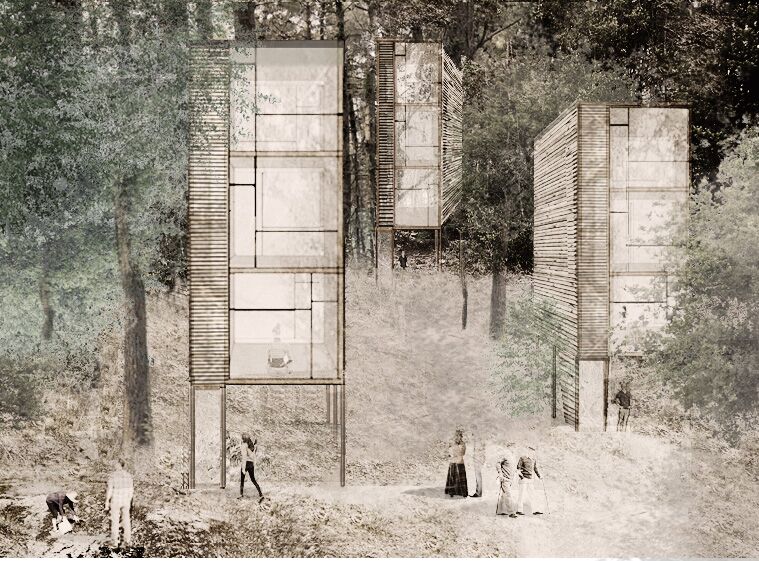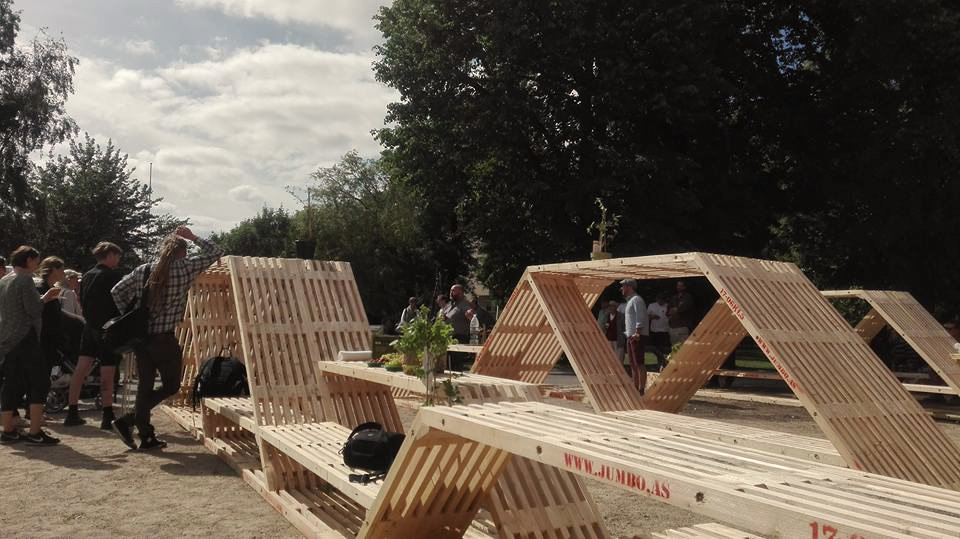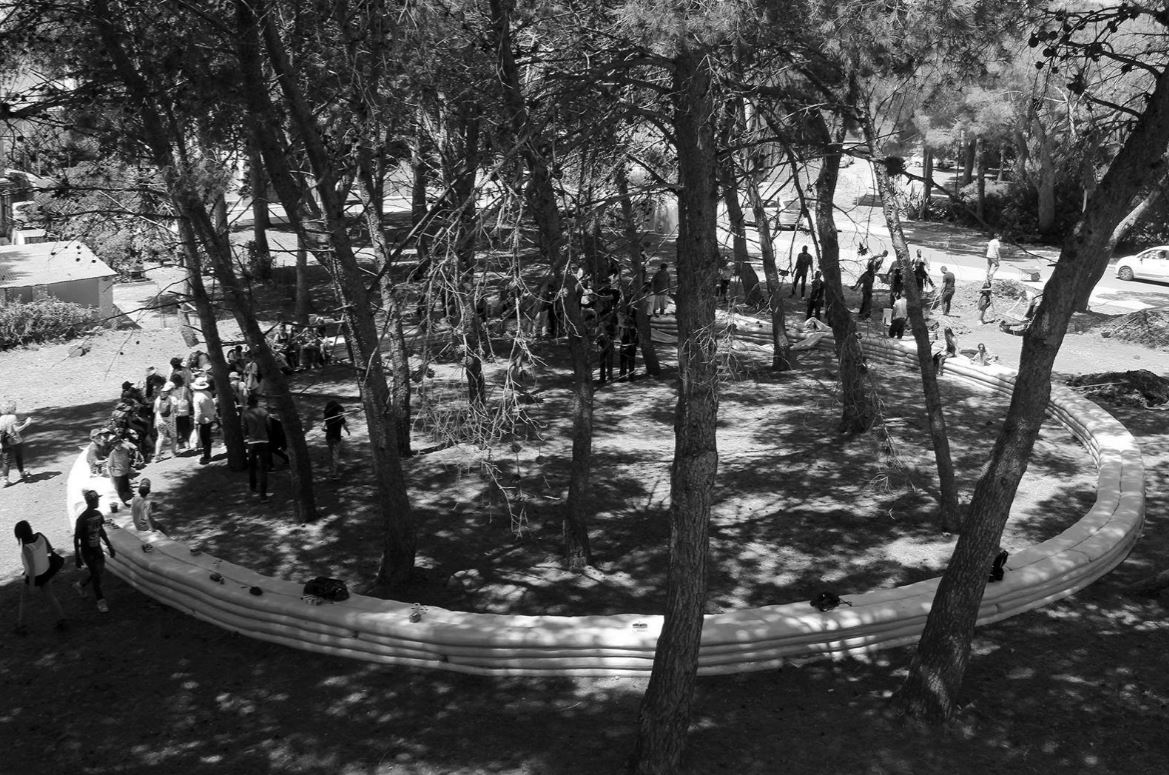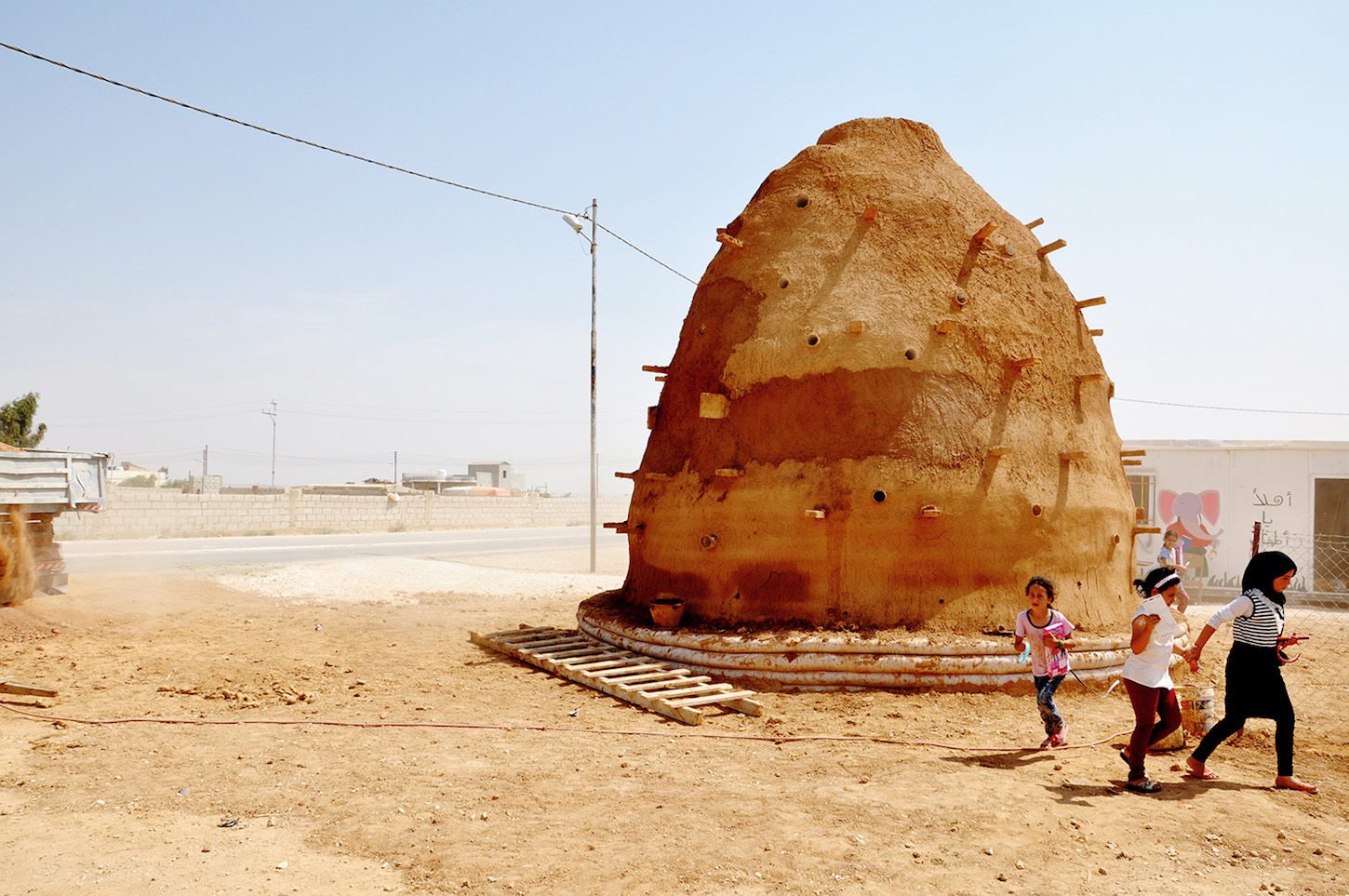Andrea Pacheco converses with Jorge Lobos about architecture as a human right and the need to develop a praxis geared towards social equality in order to step away from the logic of power that sustains the field.

Vivienda social, Chile. Fotografía cortesía de EAHR
Architecture Alone Will Not Deliver Social Change
Everyone has the right to a standard of living adequate for the health and wellbeing of themselves and their families, including food, clothing, housing and medical care and necessary social services, and the right to security in the event of unemployment, sickness, disability, widowhood, old age or other lack of livelihood in circumstances beyond their control.
— Article 25, Universal Declaration of Human Rights [1]
“This is the first and only concrete reference to architecture in the Universal Declaration of Human Rights, the first document of its type with a global scope. It is brief, precise, and sufficiently robust to be considered a foundational document for our professional labor in architecture”: Jorge Lobos (Punta Arenas, 1961) is a Chilean architect residing in Denmark who, since the 1980s, has worked on a range of projects that challenge the profession’s self-absorption—largely a result of the neoliberal doctrine that has engulfed it—transforming architecture into a tool for solving urgent problems like forced migratory displacement or the humanitarian crises produced by natural disasters and armed conflicts. Through Emergency, Architecture, and Human Rights (EAHR), an organization with offices in Copenhagen, Rome, and Santiago de Chile, Lobos has promoted different architectural projects across the world while simultaneously developing an important body of theoretical and pedagogical work, as evidenced by the publication of a series of books: Architecture for Humanitarian Emergencies (KADK, Denmark), Hacia una arquitectura cultural (Aracne, Italy), and Guía de arquitectura del Archipiélago de Chiloé (ed. Junta de Andalucía, Spain), and the creation of a master’s program in Emergency and Resilience at the Universidad IAUV in Venice.
Currently, the EAHR staff includes professionals from different disciplines including sociology, anthropology, philosophy, and art. The following conversation discusses some of the pillars of the organization’s paradigm as they have been set out by Jorge Lobos, along with dozens of his collaborators and partners in recent decades. It could contribute to the future development of a “post-capitalist” social and economic state (in the words of the British journalist Paul Mason), replacing the current system through a cooperative, collaborative, and essentially solidary model.

Escuela Pudeto, Chiloé, Chile. Fotografía cortesía de EAHR
Andrea Pacheco: I’d like to start this conversation focusing on language and the ways in which certain cultural, artistic, and architectural projects name or define their work. I’d like to get a better sense of the scope of the concept of “human rights” for you as architects.
Jorge Lobos: A conceptual emphasis on human rights is essential for comprehending the contemporary problems that strain our profession, as it is no longer possible to continue understanding the discipline of architecture from an artistic and aesthetic point of view. The relationship between architecture and human rights has been absent in architectural theory. We uphold the need and urgency to deepen and raise awareness of this ethical position in our field. In so doing, we can motivate the creation of new professional roles and will be able to bring the knowledge and experience that hundreds of years of architecture have accumulated to billions of human beings who have been ignored by our professional practice. These people have a right to enjoy and reap the benefits generated by the collective knowledge produced in the world that we all live in.
Humanity constantly produces new knowledge. This knowledge is intrinsically linked to the very essence of humanity: it is our fundamental purpose as vital, evolutionary beings. It is produced through the interaction of human collectivities; it is the sum of individual and interdependent intelligences. Every thought and every action of human evolution depends on and is due to the collective, although they can also be crystallized in an individual.
Architecture is part of this accumulated knowledge, and therefore it should be available to everyone.
From this perspective, we can understand architecture as a human right, integrated into the context and knowledge that the planet has generated. This perspective helps us to check the yearning for individualism among architects as well as the personal power that an architect may expect to hold over others. Architecture is always a collective act, humbly gregarious, purely social, and inherent to the essence of humanity.

AP: What was the specific origin of this thinking in your practice?
JL: These thoughts began two or three decades ago with the theoretical process of developing the concept of “cultural architecture” in Latin America. The discourse was primarily produced in Chile’s Chiloé Archipelago, where a group of architects, sociologists, artists, and intellectuals moved in the seventies and eighties to escape the military dictatorship. These professionals found a culturally fascinating place, previously undiscovered by architects. A universe of wood, which changed the era’s architectural thinking. The passage from one concept to another, from the “cultural processes” coined in the eighties and nineties to “human rights” in 2000, was the result of the evolution all concepts go through, especially in architecture. Maybe a key moment was when we started working on humanitarian emergencies, specifically following the earthquake and tsunami that hit Indonesia in December 2004.
Another motive for this evolution is that cultural processes are included in human rights, but the inverse is not true. In other words, the concept of human rights is broader and includes cultural processes; it is a conceptual and ethical umbrella for a series of social concerns that architecture has had for the last century. On the other hand, when we pay attention to human rights, we shift the intention of authorship and the project’s responsibility. We move away from a conception of architecture as a bearer of authority towards a practice that emphasizes the user as a being not only with needs but also with rights, who can and must be an active part of architectural and urban projects. Residents change from passive, voiceless agents infantilized by architecture and become active cultural agents bearing knowledge, talents, and responsibilities in the development of the cities and spaces we live in. The concept of human rights engages the architect’s obligations in a way that the concept of culture does not, as the latter leaves it up to the architect whether to address them or not. When human rights become a central idea in urban action, architects are forced to engage in specific ethical and socially responsible behaviors, and moreover, these behaviors extend to residents who, actively involved in the projects, begin to influence an increasingly collaborative production process with their cultural capacities and values, and with the responsibility this involves. For this reason, the valuation of human rights above individual cultural processes is necessary and fundamental.

AP: As heirs of the term “Cultural Architecture”, can you explain what this “other” cultural character is? Bearing in mind that all architecture is, essentially, a cultural phenomenon.
JL: Certainly, all architecture is cultural. At first glance, this should invalidate the concept of cultural architecture. However, precisely because all architecture is cultural, an architectural theory can exist based on this concept intrinsic to the profession. Because culture is an inherent value of architecture, we can consider the possibility of strengthening its ability to represent diverse visions that coexist in the world, and this can be shown through twentieth-century architectural theory. The main difference between each of the most important architectural periods that divided the past century was the emphasis placed on one or another inherent element unique and intrinsic to the profession, and the subsequent valuation of it over the other elements. Thus, the modern movement valued the idea of “modernity” above the other conditions of the profession, in an attempt to catch up with the social thought of the moment. But we must remember that all architectures from all times are modern or have been modern, in terms of innovation and timelines, or as Jorge Luis Borges said, “The only thing we cannot avoid is being modern.” It is in this sense that postmodernism as well as deconstructivism are modern.
Within this panorama, cultural architecture is that which consciously values human processes in various fields, understanding culture in the philosophical, ethnographic, and artistic sense of the word.

AP: Continuing with categories that seem important in your practice, do you see architecture as a form of activism? In one of your texts, the idea of “activist architecture” appears and I’d like to know how you feel about that term.
JL: We didn’t speak of “activist architecture,” but rather of the architect as a “cultural activist.”
We are interested in seeing architecture as a manifestation of equality, as a tool that fights for greater social equality, although we are fully aware that architecture alone will not deliver social change.
AP: Why not? What is the greatest obstacle preventing the expansion of this paradigm?
JL: Architecture as a practice will never be the object or vanguard of social change, since there is a cursed and logical equation that prevents it from doing so: architecture requires money. Money is behind power. It follows that architecture is the byproduct of power. Power will never seek social change, as it would be self-destructive. Power will only accept changes that allow it to remain in power. Consequently, thinking that architecture will be a tool for social change is utopian. This is the vicious cycle that encapsulates this practice. Nevertheless, we can be mindful of future political changes for which architecture can set the stage. In this sense, it is worth thinking of utopia and destroying the cycle that anchors architecture as a byproduct of power. If we succeed, for example, in breaking this cursed equation and make architecture produce money and benefits for its users, rather than requiring money for construction, we can rid ourselves of power and become the hardware for social change. Utopia.

AP: The Food and Agriculture Organization of the United Nations defines resilience as “the ability to prevent disasters and crises as well as to anticipate, absorb, accommodate or recover from them in a timely, efficient and sustainable manner.” Resilience seems to be a key aspect of your philosophy, as the focus of the Emergency and Resilience master’s program you created demonstrates. What other pedagogical activities has the EAHR spearheaded?
JL: We have three academic systems that we developed simultaneously. Through the master’s program in Venice, we connect students with international institutions that work in human rights and international aid to analyze how architecture and physical land-based interventions can influence the creation of better solutions to contemporary problems.
Another pedagogical tool is the 5×5 workshop, which we started in 2010 at the Royal Danish Academy of Fine Arts in Copenhagen. In the workshop, we choose five humanitarian emergencies from five different global contexts for simultaneous analysis. In so doing, we offer students a global perspective on the problems confronting humanity. These workshops give students the opportunity to experience the rapid completion of a project and to recognize the compelling need for collective action. It teaches them to trust in others and depend on one another, an experience we consider fundamental to their professional lives. This is urgent when we are faced with a humanitarian emergency. In recent years, we have extended the 5×5 workshop to such countries as Brazil, Chile, Italy, Latvia, Mexico, Mozambique, and Turkey.
Lastly, we host the 1+1=11 workshop, in which we bring participants from various parts of the world together to work in-person on an international aid project somewhere on the planet. The focus of this workshop is to collectively build low-cost reinterpretation solutions for local communities. Ultimately, we are working to increase social resilience using architecture as a tool.
AP: What projects are currently under development at EAHR and who are the organization’s partners?
JL: We are currently working on several projects, including 100 Classrooms for Refugee Children of the Middle East, in which we are seeking to build one hundred classrooms to educate five thousand children in Jordan’s refugee camps. We are also collaborating with the Shatila refugee camp in Beirut, Lebanon, where we are building two rooftop playgrounds. In the wake of the earthquake that struck Nepal, we are working to rebuild rural schools, and we are also developing a project that connects children with functional diversity to nature in three national parks in Chile. Additional projects include a winter shelter project for people experiencing homelessness in Copenhagen and a community center in Santa Cruz, Bolivia, among others. In these projects, we have partners at three levels: the local communities with whom we work to define the projects and their scope; our strategy partners, which include governments, NGOs, and international organizations; and donors, either partners or sponsors.

AP: Most of your projects are in Africa, South America, and the Middle East—places where there are humanitarian emergencies caused by a broad range of catastrophes—while your center of operations is in Europe. Do you take a critical position with regards to this North-South relationship? I understand this relationship as more than geographical, as the “North” also entails exploitation by the local elite, as well as systems like colonialism, racism, systemic patriarchal oppression, and class inequality.
JL: The “North-South axis” is another unsuccessful attempt to use euphemisms to define a central problem: poverty and inequality. The relationship is not necessarily North-South, since many countries in the south—Chile, for example—have a small number of millionaires at the expense of the majority of citizens. The main point of the discussion cannot be obfuscated by this invisibilizing rhetoric. North-South does not refer exclusively to geography, thus we must develop new terms to express this concept of inequality. It is essential that we recognize our complete inability to define conflicts in our world. Some speak of North-South, others of center-periphery, but there is no definition that truly explains the contemporary situation. In terms of our practice, there is a certain asymmetry in place. Our actions are part of this asymmetry. We have power when we are building structure in the “South.” In fact, we bring the money needed to pay workers. The only thing we can do is try to be as symmetrical as possible.
AP: In this sense, what strategies do you use in order to avoid replicating this type of inequality, which has its origins in colonialism, and is therefore based on racism and patriarchy, and which indirectly and even involuntarily replicates these paradigms?
JL: Our action on the ground is centered on providing a professional service that may reduce asymmetry but doesn’t eliminate it. We try to eliminate the patriarchal figure of the architect as a powerful nineteenth-century creator who controls and directs the whole design and construction process, instead relying on co-creation, co-construction, and increasing community resilience in order to transform production into a humanist experience.
However, we are conscious that while our position reduces this asymmetry, it does not eliminate it. Architecture should propose a system of rules that organize social relations for the creation of a structure, while relaxing power and control of the final architectural product. This is difficult as our university education has prepared us to have aesthetic power. It is hard for us to visualize others’ ideas.
In my case, coming from a poor region of a mid-tier country like Chile, it’s hard for me to have a colonial perspective. However, growing up in a country that is rabidly Catholic, racist, and that hates and is ashamed of its indigenous people has certainly affected me. When we travel to build, we are always astonished by traditional architecture, which is the wisest and most connected to nature and human needs. We are interested in moving ideas from one context to another, even if they are very different: How can we reproduce the salt block technique of Egyptian oases in a South American country, or how can we use earthenware brick domes from the Middle East in the Nepalese mountains?








Comments
There are no coments available.